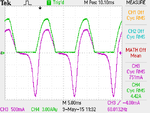The Electrician
Full Member level 5
- Joined
- Jul 13, 2010
- Messages
- 299
- Helped
- 141
- Reputation
- 282
- Reaction score
- 142
- Trophy points
- 1,323
- Location
- Pacific NW
- Activity points
- 4,586
It depends on the nature & size of the DC load on the sec.HTML:Ok. Suppose the transformer is a 1 kW isolation transformer with E-I laminations, loaded as I described in post #12. Typically, what DC current would one expect in the primary?
.
The load is a 50Ω in series with a diode. What DC current in the primary would you expect in this case?
